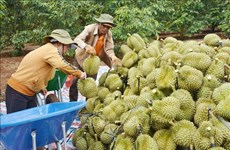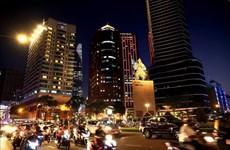HCM City’s retail, services sales up 14.4 percent
The retail sales and service revenue in Ho Chi Minh City reached more than 94.91 trillion VND (4.07 billion USD) in April, up 2.3 percent from the previous month.
 Illustrative image (Source: VNA)
Illustrative image (Source: VNA)HCM City (VNA) – The retail sales and service revenue in Ho Chi Minh City reached more than 94.91 trillion VND (4.07 billion USD) in April, up 2.3 percent from the previous month and 14.4 percent from the same time last year, boosted by strong promotional campaigns by shopping malls and supermarkets during national holidays.
Reports from competent authorities showed that revenues went up in the sales of rice (0.6 percent); beef (0.17 percent); confectionary (0.35 percent); and tea, coffee, and cocoa (0.52 percent). Meanwhile, earnings from pork products fell by 3.36 percent, poultry 0.66 percent, seafood 1.79 percent, vegetables 1.91 percent, and fruits 0.06 percent.
According to the municipal Department of Industry and Trade, the sufficient supply coupled with the effective market stabilisation programme have kept food prices steady since the beginning of the year.
The two adjustments in oil and gas prices in April only impacted the transport sector, driving coach and train fares to rise by 0.56 percent and 2.67 percent, respectively.
Deputy General Director of Saigon Co.op Nguyen Anh Duc said that his company has joined hands with suppliers to ensure price stability. The retail chain – which runs Co.opmart, Co.opXtra, and Co.opfood – will focus on essential commodities and continue to run promotional programmes to bolster purchasing power.
Duc affirmed that Saigon Co.op will avoid irrational price hikes to protect consumer rights.
Other retailers in the city said that in the context of weakened spending power, distributors and suppliers should join hands to stabilise the market.
In traditional markets, price increases were seen in fresh and frozen food products following surges in fuel and electricity prices.
A local business association said that they want to receive support from relevant authorities amid market volatility so as to ensure logical production plans can be made.
Ho Chi Minh City is now home to 13 million residents, with expanding demands for food. However, the city is only able to meet 20-30 percent of the total daily consumption, relying heavily on imports and supplies from other cities and provinces.–VNA













